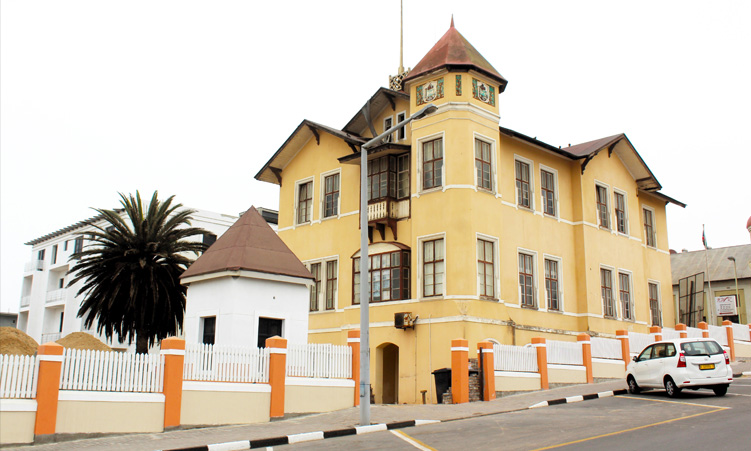The Ministry of Environment, Forestry and Tourism (MEFT) has addressed concerns over the dilapidated state of its office building at Swakopmund, a key concern for both heritage preservation and the tourism sector in Namibia.
MEFT spokesperson Romeo Muyunda on Wednesday told The Namibian about the ministry’s plans for renovation, scheduled to begin between April and May, with completion targeted for August or September.
“The ministry is finalising the tender process to appoint a contractor for the renovation. We have reserved about N$2,6 million for this project, underlining our commitment to not only preserving a building listed under the Heritage Council of Namibia but also enhancing our service to tourists.”
The office building, critical for servicing tourists visiting the coastal parks, is part of a broader parks development project co-financed by the Federal Republic of Germany through the German Ministry of Economic Cooperation and Development and the KfW Development Bank.
Muyunda highlighted the ministry’s broader commitment to infrastructure development in the region, including the expansion of the Swakopmund office with a new office block that started in 2015. Despite initial delays due to poor workmanship and procurement challenges, the project is now 83% complete, with a new completion date set for April.
“This expansion is crucial for enhancing our operational capacity and service delivery to both the public and tourists,” Muyunda said.
MEFT has allocated an additional N$5 million for the renovation and expansion of its Walvis Bay office, with the project expected to commence this year. Muyunda acknowledged the financial constraints facing the country, emphasising that the ministry is prioritising its resources to address various needs, including the maintenance and development of public infrastructure.
“The current economic situation poses challenges, but it has not deterred our resolve to ensure that our public infrastructure, especially those serving the tourism sector, are not only preserved but also enhanced,” Muyunda said.
The building’s deteriorating condition has not gone unnoticed, especially by those who view it as the gateway for tourists seeking to explore Erongo’s heritage.
Almuth Styles of Namib I tourism information centre, a prominent figure in the local tourism sector, voiced her concerns, emphasising the paradox of the building’s physical state versus the quality of service it houses.
“It is heartbreaking to see that building like that, especially with the long and rich history it has,” Styles said.
She pointed out that many tourists must navigate the dilapidated structure to obtain the necessary documents and permits.
The building is known as the Ritterburg and was built in 1906. It was the home of Theodor Ritter, who was responsible for receiving shipped goods for the shipping company, Woermann Linie.
Despite the building’s state, Styles was quick to praise the staff, describing them as “polite and friendly”. She stressed that the focus should not detract from their commendable service.
According to her, the slow pace in development and renovation can be attributed to a series of unfortunate events, including the impacts of Covid-19 and construction delays on adjacent projects.
Styles highlighted the urgent need for repairs, particularly to the building’s roof and yard, suggesting that even minimal enhancements would significantly improve its appearance.
“Sometimes, also just a plant or two in the backyard would do some things special,” she said while noting the efforts of the staff to maintain cleanliness and order inside the building.
“The ladies inside keep it in good nick,” she said, acknowledging the constant battle against the dust and debris from nearby construction.
The ministry’s comments come after several complaints and concerns from the Swakopmund public and businesses were posted on social media, while the Swakopmund Residents Association (SRA) also issued a plea to the government to make the restoration of several government buildings a priority.
“Over the past few years, the condition of several government-owned buildings at Swakopmund has deteriorated significantly,” said SRA chairman John Hopkins.
“These buildings, which once served as vital public institutions, now stand as remnants of neglect and disrepair, impacting the overall image and well-being of our community.”
Hopkins said the dilapidated buildings are not just an eyesore, but a health and safety risk.
“The crumbling infrastructure and lack of maintenance not only pose safety risks, but also create an atmosphere of inefficiency and disorganisation,” he warned, adding that this situation is particularly alarming in government office buildings located in the heart of Swakopmund, where the delivery of public services is compromised by the unpleasant and inhospitable environments.
Despite acknowledging financial constraints, Hopkins highlighted the necessity of prioritising the regeneration and maintenance of these buildings.
He said this would not only preserve Swakopmund’s cultural heritage, but also ensure the provision of government services in decent and functional spaces.
Hopkins expressed his readiness to support and participate in community-driven campaigns aimed at addressing this pressing issue.
“I am confident that with your vision and leadership, we can make a positive change,” he said.
Stay informed with The Namibian – your source for credible journalism. Get in-depth reporting and opinions for
only N$85 a month. Invest in journalism, invest in democracy –
Subscribe Now!






